法国美食人文介绍(英语)
- 格式:ppt
- 大小:3.74 MB
- 文档页数:15

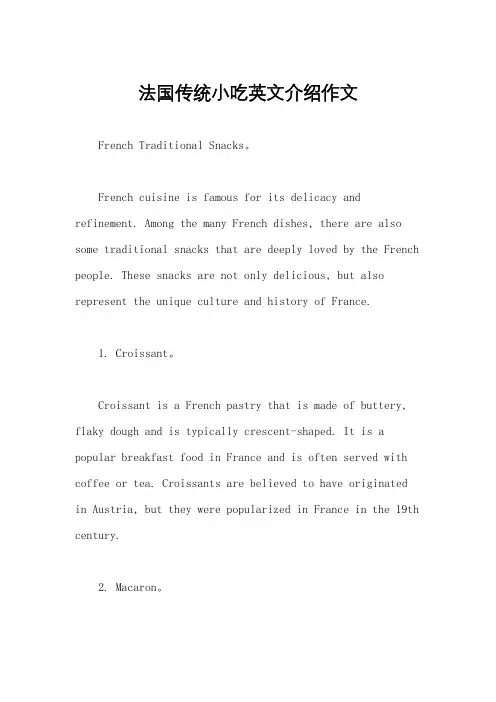
法国传统小吃英文介绍作文French Traditional Snacks。
French cuisine is famous for its delicacy and refinement. Among the many French dishes, there are also some traditional snacks that are deeply loved by the French people. These snacks are not only delicious, but also represent the unique culture and history of France.1. Croissant。
Croissant is a French pastry that is made of buttery, flaky dough and is typically crescent-shaped. It is a popular breakfast food in France and is often served with coffee or tea. Croissants are believed to have originated in Austria, but they were popularized in France in the 19th century.2. Macaron。
Macarons are small, round cookies that are made of almond flour, sugar, and egg whites. They are typicallyfilled with buttercream or ganache and come in a variety of flavors, such as chocolate, raspberry, and pistachio. Macarons have been a French delicacy since the 16th century.3. Crème Brûlée。
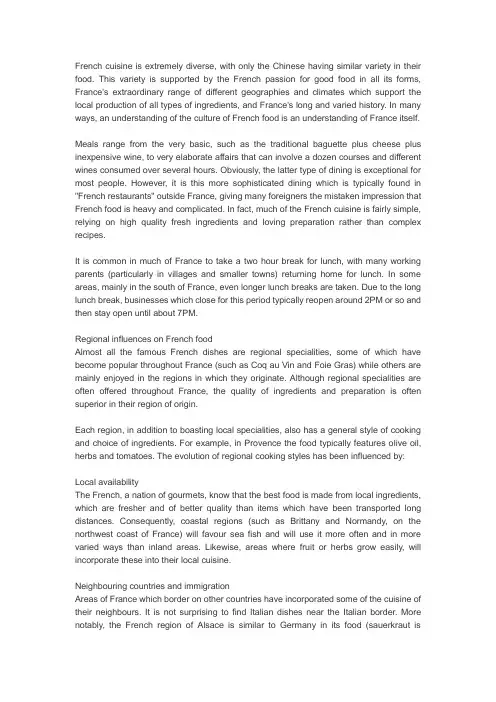
French cuisine is extremely diverse, with only the Chinese having similar variety in their food. This variety is supported by the French passion for good food in all its forms, France's extraordinary range of different geographies and climates which support the local production of all types of ingredients, and France's long and varied history. In many ways, an understanding of the culture of French food is an understanding of France itself.Meals range from the very basic, such as the traditional baguette plus cheese plus inexpensive wine, to very elaborate affairs that can involve a dozen courses and different wines consumed over several hours. Obviously, the latter type of dining is exceptional for most people. However, it is this more sophisticated dining which is typically found in "French restaurants" outside France, giving many foreigners the mistaken impression that French food is heavy and complicated. In fact, much of the French cuisine is fairly simple, relying on high quality fresh ingredients and loving preparation rather than complex recipes.It is common in much of France to take a two hour break for lunch, with many working parents (particularly in villages and smaller towns) returning home for lunch. In some areas, mainly in the south of France, even longer lunch breaks are taken. Due to the long lunch break, businesses which close for this period typically reopen around 2PM or so and then stay open until about 7PM.Regional influences on French foodAlmost all the famous French dishes are regional specialities, some of which have become popular throughout France (such as Coq au Vin and Foie Gras) while others are mainly enjoyed in the regions in which they originate. Although regional specialities are often offered throughout France, the quality of ingredients and preparation is often superior in their region of origin.Each region, in addition to boasting local specialities, also has a general style of cooking and choice of ingredients. For example, in Provence the food typically features olive oil, herbs and tomatoes. The evolution of regional cooking styles has been influenced by:Local availabilityThe French, a nation of gourmets, know that the best food is made from local ingredients, which are fresher and of better quality than items which have been transported long distances. Consequently, coastal regions (such as Brittany and Normandy, on the northwest coast of France) will favour sea fish and will use it more often and in more varied ways than inland areas. Likewise, areas where fruit or herbs grow easily, will incorporate these into their local cuisine.Neighbouring countries and immigrationAreas of France which border on other countries have incorporated some of the cuisine of their neighbours. It is not surprising to find Italian dishes near the Italian border. More notably, the French region of Alsace is similar to Germany in its food (sauerkraut ispopular) and wine, partly due to it currently bordering on Germany and partly due to it having been part of Germany at various points in its history (the border has moved back and forth with various wars). In parts of the south which have a large North African immigrant population one can enjoy the cuisine which they have imported from their original countries.History and economic conditionsThe culture, lifestyle and economic conditions over a long period of time have formed the development of local food traditions. The rich meat dishes and cream sauces of Burgundy are not only due to Burgundian excellence in raising cattle, but in large part to the economic prosperity of this region over several centuries. On the other hand, mountain regions excel in firm cheeses, which allow food to be preserved over the long and difficult winters, and can be produced from mountain livestock which historically were the main means of support for many families in economically limited areas.In all parts of France one will find a range of dishes, both in restaurants and in homes, which extends far beyond the regional specialities. However, in much of France the regional influences in terms of ingredients and cooking are marked. The most available food and the best cooking tend to be those produced from local ingredients and using local recipes. Therefore, the decision of where to visit or live in France tends to influence which types of food one will enjoy.The French Mediterranean uses olive oil, herbs and tomatoes in many of its dishes. The cuisine of northwest France uses butter, soured cream (crème fraiche) and apples. The cuisine of northeast France (Alsace, and to a lesser extent Lorraine) has a strong German influence which includes beer and sauerkraut. Throughout the south in general there tends to be more use of vegetables and fruit (in part due to the favourable climate). Near the Atlantic coast and the Mediterranean there is a greater consumption of sea food, while inland areas favoured by rivers (e.g. the Loire valley) use more fresh water fish.The Italian connectionAny discussion of the influences on French cuisine would be incomplete without recognising the historical contribution of Italy to the development of French cooking. In 1533, Catherine De Medicis (a Florentine princess) married Henry duc d'Orleans (who became King Henry II or France). At this point, France was not know for its food or food culture. Catherine brought an entourage of Italian chefs with her to France, who introduced to France a variety of dishes, food preparation and dining practices. Although France and Italy obviously have evolved very different food cultures, both before and since this contribution, much of France's current food culture can be traced back to this time.Cooking stylesEvery region of France has its own distinctive traditions in terms of ingredients and preparation (see France Regions for further information). On top of this, there are threegeneral approaches which compete with each other:Classical French cuisine (also known in France as cuisine bourgeoise).This includes all the classical French dishes which were at one time regional, but are no longer specifically regional. Food is rich and filling, with many dishes using cream-based sauces.Haute cuisineIt is classical French cuisine taken to its most sophisticated and extreme. Food is elegant, elaborate and generally rich. Meals tend to be heavy, especially due to the use of cream and either large portions or many smaller portions. There is a strong emphasis on presentation (in particular, vegetables tend to be cut with compulsive precision and uniformity). The finest ingredients are used, and the meal is correspondingly expensive.Cuisine Nouvelle.This style developed in the 1970s, as a reaction against the classical school of cooking. The food is simpler and lighter. Portions are smaller and less rich; the heavy cream sauces of the classical approach are particularly avoided. Cooking is less elaborate and quicker, with more emphasis on local and seasonal ingredients.Cuisine du terroir.This focuses on regional specialities and is somewhat more rustic in nature. Local produce and food traditions are the main focus.Each of these three traditions are strongly represented in France, with each having its supporters and specialist restaurants. At the moment, Cuisine Nouvelle is less popular than it was, while Cuisine du terroir has grown in popularity in recent years.Wine and cheeseAside from bread and water, the most common accompaniments to a French meal are wine and cheese. Unlike other countries, in France wine is considered a standard part of everyday meals, and is neither expensive nor reserved for special occasions. With everyday meals, ordinary wines are served, although it is expected that the style of wine match the style of food.In addition to its use in cooking, cheese is often served as a course in itself. In this case, it is served after the main meal but before dessert. This typically consists of a platter with three or four different cheeses, from which guests can slice pieces according to their preferences. Sliced bread (e.g. slices of a baguette) are typically provided at the same time.Restaurant guidesThe most famous and successful restaurant guide in France is the Michelin Guide Rouge, which has approximately 50% market share. It has enormous influence; the award of asingle star by the Guide Rouge to a restaurant can add 25% to its turnover and the loss of a star can mean financial ruin for a restaurant.The Guide Rouge is both a restaurant guide and a hotel guide, although its better known for the former. For the towns in the Guide Rouge there is a list of the main tourist attractions and for the larger towns there is a map. In addition to having one in the house it is handy to have one in the car (e.g. if you are unexpectedly delayed on a journey and need to find a good local restaurant).Although the Guide Rouge does not provide exact details on the criteria they use for rating restaurants, there are a number of factors beside the quality of food: service, atmosphere and value are some of the other considerations. This perhaps explains our experience that not all restaurants with the same overall rating have the same quality of food, one restaurant may have tremendous atmosphere and average food while another with the same rating may have exceptional food but little atmosphere. The Guide Rouge sometimes makes a few comments under a recommended restaurant; these are worth reading as they give an indication of what aspect of the restaurant impressed the reviewer. The comments sometimes note specialities of the house, which are often the best items on the menu.参考译文:法国的美食是非常多样的,只有中国有与之匹敌的食品种类。

cuisine法国饮食文化英文版Italy and French cuisineGood afternoon, everyone, we today talk about food in Italy and French.I know it’s hard to understand it, which only through human senses, like taste, smell, touch, and eat can be impressed. So the aim of our ppt is make you know everything of something, not something of everything. My topic divides into 2 big parts, Italy and France, and there are almost 3 listed cuisines in each.Part 1 Italy1) When it comes to Italy food, the first occurs to us should be Spaghetti. Before we know it, we should know pasta, a food made from a mixture of flour, water, and sometimes eggs that is formed into different shapes (such as thin strips, tubes, or shells) and usually boiled(面条的统称), and spaghetti is one kind of it. There are over 130 pasta.Alphabets - 字母面,通常字母面是用来放在汤里起点缀作用的。
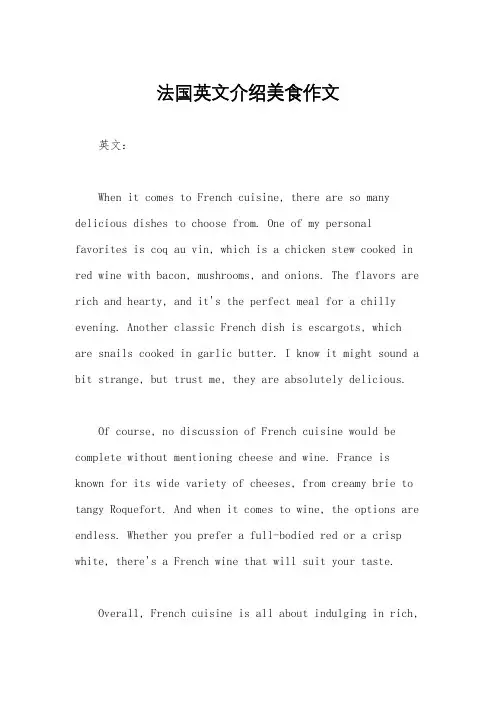
法国英文介绍美食作文英文:When it comes to French cuisine, there are so many delicious dishes to choose from. One of my personal favorites is coq au vin, which is a chicken stew cooked in red wine with bacon, mushrooms, and onions. The flavors are rich and hearty, and it's the perfect meal for a chilly evening. Another classic French dish is escargots, which are snails cooked in garlic butter. I know it might sound a bit strange, but trust me, they are absolutely delicious.Of course, no discussion of French cuisine would be complete without mentioning cheese and wine. France is known for its wide variety of cheeses, from creamy brie to tangy Roquefort. And when it comes to wine, the options are endless. Whether you prefer a full-bodied red or a crisp white, there's a French wine that will suit your taste.Overall, French cuisine is all about indulging in rich,flavorful dishes and enjoying the finer things in life.It's no wonder that France is known as a culinary capitalof the world.中文:说到法国美食,有很多美味的菜肴可供选择。
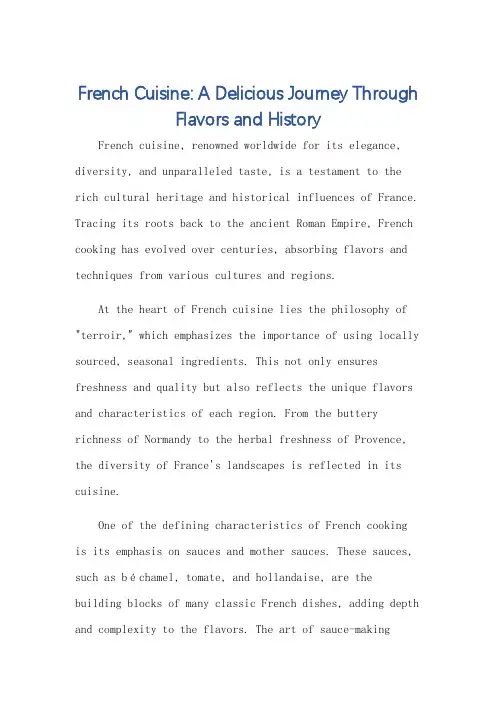
French Cuisine: A Delicious Journey ThroughFlavors and HistoryFrench cuisine, renowned worldwide for its elegance, diversity, and unparalleled taste, is a testament to the rich cultural heritage and historical influences of France. Tracing its roots back to the ancient Roman Empire, French cooking has evolved over centuries, absorbing flavors and techniques from various cultures and regions.At the heart of French cuisine lies the philosophy of "terroir," which emphasizes the importance of using locally sourced, seasonal ingredients. This not only ensures freshness and quality but also reflects the unique flavors and characteristics of each region. From the buttery richness of Normandy to the herbal freshness of Provence, the diversity of France's landscapes is reflected in its cuisine.One of the defining characteristics of French cooking is its emphasis on sauces and mother sauces. These sauces, such as béchamel, tomate, and hollandaise, are thebuilding blocks of many classic French dishes, adding depth and complexity to the flavors. The art of sauce-makingrequires precision and skill, resulting in sauces that are both flavorful and harmonious with the main dish.Bread, another cornerstone of French cuisine, is an integral part of every meal. From the crusty baguettes to the soft, rich brioches, French bread is a testament to the craftsmanship and tradition of French baking. It is often served with meals, either as an accompaniment or as a standalone snack, and its unique flavor and texture complement various dishes.Cheese, another essential element of French cuisine, is as diverse as the country itself. With hundreds ofvarieties ranging from the mild and creamy Camembert to the strong and pungent Roquefort, French cheese is a celebration of taste and texture. It is often served as an appetizer or dessert, paired with wine or fruit, and its unique flavors add a touch of elegance to any meal.Pastries and desserts are another highlight of French cuisine. From the flaky croissants and delicate macarons to the rich chocolate mousse and creamy crèm e brûlée, French pastries are a treat for the senses. These dessertsare often a labor of love, requiring meticulous attention to detail and the use of high-quality ingredients.French cuisine is not just a collection of recipes or dishes; it's a cultural experience that embodies the essence of France. It's a reflection of the country's rich history, diverse landscapes, and passionate love for good food. From the bustling markets to the elegant restaurants, France is a culinary paradise that offers an endless journey through flavors and traditions.**法国美食:一场风味与历史的美妙之旅**法国美食,以其优雅、多样化和无与伦比的美味而享誉全球,是法国丰富文化遗产和历史影响的有力证明。


法国菜肴介绍英语作文French Cuisine: A Culinary Journey。
French cuisine is renowned worldwide for its elegance, refinement, and rich flavors. Rooted in centuries of culinary tradition and influenced by diverse regional ingredients, French cooking is a testament to artistry and passion in the kitchen. In this essay, we will delve into the essence of French cuisine, exploring its history, key ingredients, iconic dishes, and enduring impact on the global culinary scene.Historical Background:French cuisine has a rich and storied history that dates back to the Middle Ages. During this period, French nobility employed talented chefs to create elaborate feasts that showcased their wealth and power. These chefs laid the foundation for what would later become known as haute cuisine, characterized by meticulous preparation, intricatepresentation, and luxurious ingredients.In the 17th century, King Louis XIV played a pivotalrole in elevating French cuisine to new heights by establishing the first professional guild of chefs, knownas the Guild of Cooks. This guild standardized cooking techniques, codified recipes, and promoted culinary innovation, laying the groundwork for the development of French culinary arts.Key Ingredients:French cuisine is characterized by its emphasis on fresh, high-quality ingredients that are carefully sourced and expertly prepared. Some of the staple ingredients in French cooking include:1. Butter: Butter is a fundamental element in French cuisine, prized for its rich flavor and creamy texture. Itis used gene rously in sauces, pastries, and sautéed dishes, imparting a distinctive richness to French recipes.2. Wine: Wine holds a revered status in French cooking, both as a beverage and as an ingredient in many dishes. From Coq au Vin to Beef Bourguignon, wine adds depth of flavor and complexity to French cuisine.3. Cheese: France is renowned for its vast array of cheeses, ranging from soft and creamy Brie to pungent Roquefort. Cheese is often served as a standalone course or incorporated into dishes su ch as quiches, soufflés, and gratins.4. Fresh Produce: French cuisine celebrates the bounty of the land, with an emphasis on seasonal fruits and vegetables. From tender asparagus in the spring to hearty root vegetables in the winter, fresh produce forms the foundation of many French dishes.5. Herbs and Spices: Herbs such as thyme, rosemary, and tarragon, along with spices like mustard seed, cloves, and nutmeg, are used to add depth and flavor to French cuisine. These aromatic ingredients are used judiciously to enhance the natural essence of the dish.Iconic Dishes:French cuisine boasts a myriad of iconic dishes that have captivated palates around the world. Some of the most beloved French delicacies include:1. Coq au Vin: This classic dish features chicken braised in red wine with mushrooms, onions, and bacon, resulting in tender, flavorful meat enveloped in a rich, velvety sauce.2. Boeuf Bourguignon: A hearty stew made with beef braised in red wine, Boeuf Bourguignon is a quintessential French comfort food. It is typically seasoned with garlic, onions, carrots, and herbs, resulting in a dish that is both rustic and refined.3. Bouillabaisse: Hailing from the port city of Marseille, Bouillabaisse is a traditional Provençal fish stew made with a variety of seafood, including fish, shellfish, and mollusks. It is flavored with saffron,garlic, tomatoes, and a hint of orange zest, creating a dish that is as vibrant as it is delicious.4. Quiche Lorraine: Originating from the Lorraine region of France, this savory tart is filled with a custard made from eggs, cream, and bacon, then baked until golden and set. Quiche Lorraine is a versatile dish that can be enjoyed for breakfast, brunch, or lunch.5. Crème Brûlée: A classic French dessert, CrèmeBrûlée is made with rich, velvety custard that is topped with a layer of caramelized sugar. The contrast between the creamy custard and the crisp, caramelized topping makes for a sublime culinary experience.Global Influence:French cuisine has had a profound impact on the global culinary landscape, influencing chefs and home cooks alike with its emphasis on technique, flavor, and presentation. French culinary techniques, such as sautéing, braising, and baking, are taught in culinary schools around the worldand form the basis of many international cuisines.Moreover, French culinary traditions continue toinspire chefs to push the boundaries of creativity and innovation. From molecular gastronomy to fusion cuisine, the principles of French cooking serve as a springboard for culinary experimentation and exploration.In conclusion, French cuisine is a celebration of artistry, tradition, and gastronomic excellence. From the bustling bistros of Paris to the quaint countryside kitchens of Provence, French cooking captivates the senses and nourishes the soul. With its rich history, diverse ingredients, and iconic dishes, French cuisine remains an enduring symbol of culinary mastery and sophistication.。
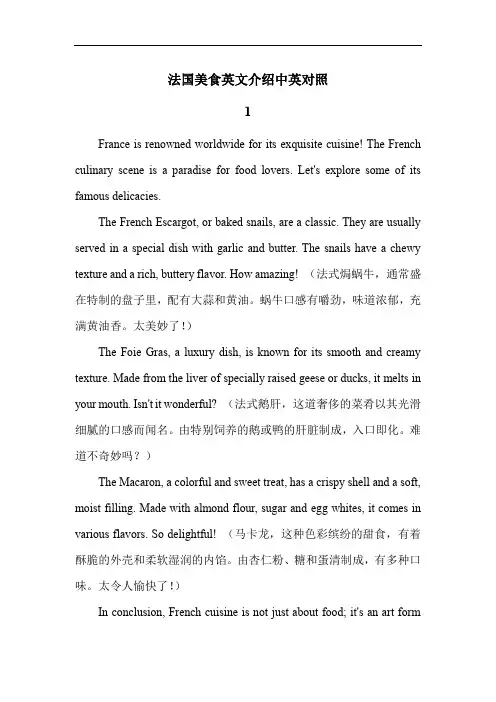
法国美食英文介绍中英对照1France is renowned worldwide for its exquisite cuisine! The French culinary scene is a paradise for food lovers. Let's explore some of its famous delicacies.The French Escargot, or baked snails, are a classic. They are usually served in a special dish with garlic and butter. The snails have a chewy texture and a rich, buttery flavor. How amazing! (法式焗蜗牛,通常盛在特制的盘子里,配有大蒜和黄油。
蜗牛口感有嚼劲,味道浓郁,充满黄油香。
太美妙了!)The Foie Gras, a luxury dish, is known for its smooth and creamy texture. Made from the liver of specially raised geese or ducks, it melts in your mouth. Isn't it wonderful? ((法式鹅肝,这道奢侈的菜肴以其光滑细腻的口感而闻名。
由特别饲养的鹅或鸭的肝脏制成,入口即化。
难道不奇妙吗?)The Macaron, a colorful and sweet treat, has a crispy shell and a soft, moist filling. Made with almond flour, sugar and egg whites, it comes in various flavors. So delightful! (马卡龙,这种色彩缤纷的甜食,有着酥脆的外壳和柔软湿润的内馅。
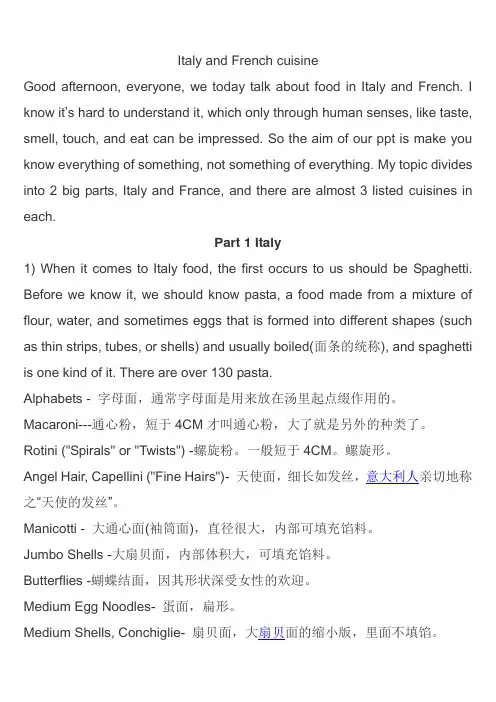
Italy and French cuisineGood afternoon, everyone, we today talk about food in Italy and French. I know it’s hard to understand it, which only through human senses, like taste, smell, touch, and eat can be impressed. So the aim of our ppt is make you know everything of something, not something of everything. My topic divides into 2 big parts, Italy and France, and there are almost 3 listed cuisines in each.Part 1 Italy1) When it comes to Italy food, the first occurs to us should be Spaghetti. Before we know it, we should know pasta, a food made from a mixture of flour, water, and sometimes eggs that is formed into different shapes (such as thin strips, tubes, or shells) and usually boiled(面条的统称), and spaghetti is one kind of it. There are over 130 pasta.Alphabets - 字母面,通常字母面是用来放在汤里起点缀作用的。
Macaroni---通心粉,短于4CM才叫通心粉,大了就是另外的种类了。
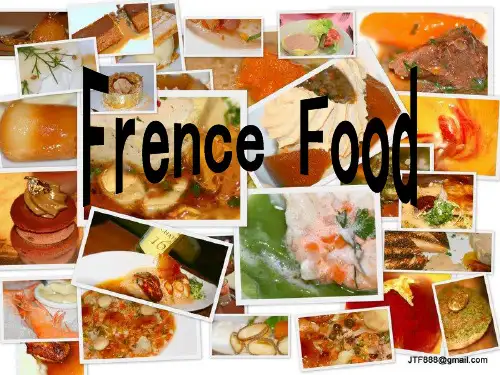
法国饮食文化英文作文介绍下载温馨提示:该文档是我店铺精心编制而成,希望大家下载以后,能够帮助大家解决实际的问题。
文档下载后可定制随意修改,请根据实际需要进行相应的调整和使用,谢谢!并且,本店铺为大家提供各种各样类型的实用资料,如教育随笔、日记赏析、句子摘抄、古诗大全、经典美文、话题作文、工作总结、词语解析、文案摘录、其他资料等等,如想了解不同资料格式和写法,敬请关注!Download tips: This document is carefully compiled by theeditor. I hope that after you download them,they can help yousolve practical problems. The document can be customized andmodified after downloading,please adjust and use it according toactual needs, thank you!In addition, our shop provides you with various types ofpractical materials,such as educational essays, diaryappreciation,sentence excerpts,ancient poems,classic articles,topic composition,work summary,word parsing,copyexcerpts,other materials and so on,want to know different data formats andwriting methods,please pay attention!France is known for its rich culinary traditions and exquisite cuisine. French food culture is deeply rooted in the country's history and is celebrated for its emphasis on fresh ingredients, bold flavors, and meticulous preparation techniques.One of the most iconic aspects of French cuisine is its love for bread. The French take their bread very seriously, and it is an essential part of every meal. From the classic baguette to the crusty country loaf, there is a widevariety of breads to choose from. The French believe that good bread should have a crispy crust and a soft, chewy interior. It is often enjoyed with butter or cheese, orused to make sandwiches.Cheese is another important component of French cuisine. France is known for its wide variety of cheeses, with over 400 different types to choose from. Each region has its own specialty cheese, made using traditional methods and localingredients. From creamy Camembert to tangy Roquefort, there is a cheese to suit every palate. Cheese is often served after the main course, accompanied by a glass of wine.Speaking of wine, France is renowned for its wine production. The country is home to some of the world's finest vineyards and produces a wide range of wines, from sparkling Champagne to full-bodied Bordeaux. Wine is an integral part of French culture and is enjoyed with meals, as well as on its own. French wine is known for its complexity and depth of flavor, and wine tasting is considered an art form in itself.French cuisine is also famous for its rich sauces and intricate cooking techniques. The French have perfected the art of sauce-making, with classics like bechamel, hollandaise, and veloute. These sauces are the foundation of many French dishes and are used to enhance the flavors of meats, vegetables, and seafood. French cooking techniques, such as braising, sautéing, and poaching, are designed to bring out the natural flavors of theingredients and create harmonious and balanced dishes.Desserts are a highlight of French cuisine, with classics like crème brûlée, tarte tatin, and macarons. French desserts are known for their delicate flavors and exquisite presentation. Pastry chefs in France are highly skilled and pay great attention to detail, creating desserts that are not only delicious but also visually stunning. French desserts are often enjoyed with a cup of coffee or tea, and are the perfect way to end a meal.In conclusion, French cuisine is a celebration of food and flavors. From the love for bread and cheese to the art of sauce-making and pastry, French food culture is diverse and vibrant. It is a true reflection of the country's history, traditions, and passion for gastronomy. Whether you're indulging in a croissant for breakfast or savoring a multi-course dinner, French cuisine never fails to delight the senses.。
法国菜肴介绍英文作文English Answer:The world of French cuisine is an exquisite tapestry woven with centuries of culinary artistry and cultural refinement. From the bustling brasseries of Paris to the Michelin-starred restaurants of the French countryside, France's culinary landscape is a symphony of flavors, traditions, and innovation.One of the hallmarks of French cuisine is its emphasis on fresh, seasonal ingredients. France's diverse climate and geography provide an abundance of culinary treasures, from the oysters of Normandy to the lavender of Provence. Chefs pride themselves on sourcing the finest ingredients and using them to create dishes that showcase their natural flavors.Another defining characteristic of French cuisine isits intricate and refined techniques. Classic Frenchcooking involves a series of complex procedures, such as braising, roasting, and sautéing. These techniques are carefully calibrated to extract the maximum flavor and texture from each ingredient. French chefs are also masters of sauces, which are used to enhance and complement the main dishes.The variety of French cuisine is simply staggering. From the iconic dishes of haute cuisine to the comforting flavors of traditional home cooking, there is a culinary adventure to be found in every corner of France. Some of the most famous dishes include:Escargot: Snails cooked in garlic butter。
用英语介绍法国的一道菜作文Introducing a Culinary Delight from France: Coq au VinFrance, renowned for its exquisite cuisine and culinaryartistry, offers a vast array of dishes that tantalize the tastebuds and evoke a sense of elegance and tradition. Amongthese gastronomic treasures, Coq au Vin stands as a timelessclassic, encapsulating the essence of French cooking with itsrich flavors and historical significance.Coq au Vin, translating to "rooster in wine," is a hearty,slow-cooked stew originating from the Burgundy region ofFrance. Its origins can be traced back to medieval times whenrural households would cook tough, older roosters with localred wine to tenderize the meat. Today, chickens are morecommonly used, yet the dish retains its rustic charm and depthof flavor.The preparation of Coq au Vin is a symphony ofingredients and techniques. It begins with marinating piecesof chicken overnight in a robust red wine, typically a Burgundy,along with garlic, herbs such as thyme and bay leaves, and adash of brandy. This process infuses the meat with a deep,wine-infused aroma.The next day, the chicken is seared to golden perfection,sealing in the juices, before being combined with a mélange of vegetables—bacon lardons, onions, mushrooms, and carrots. These ingredients are then simmered gently in the marinade, allowing the flavors to meld and intensify over several hours. The result is a sauce so rich and complex that it coats the palate with layers of savory goodness.What sets Coq au Vin apart is its balance of flavors: the tangy acidity of the wine, the smokiness of the bacon, the earthiness of the mushrooms, and the sweetness of the caramelized onions all harmoniously come together. Served traditionally with creamy mashed potatoes or crusty bread, this dish embodies the essence of comfort food elevated to fine dining standards.Coq au Vin is more than just a meal; it's a culinary experience that tells a story of French culinary heritage, where simplicity meets sophistication. It invites you to savor each bite, to appreciate the careful craftsmanship behind each ingredient, and to understand why French cuisine is celebrated worldwide. So, the next time you have the opportunity, indulge in this delightful dish and let it transport you to the heart of France, where every meal is a celebration of life's simple pleasures.。